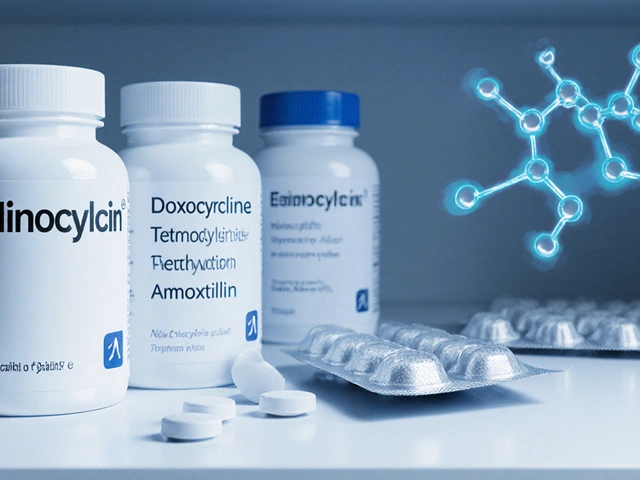Looking for alternatives to Amoxil in 2025? Good news—there are quite a few options out there. Whether you're dealing with allergies, resistance, or specific bacterial infections, knowing your options can make all the difference. One popular alternative is Erythromycin, also known as Ery-tab.
Erythromycin (Ery-tab)
This macrolide antibiotic is great for treating atypical bacterial infections like Legionella and Mycoplasma. It's also handy for strep throat and pertussis, available in straightforward delayed-release tablets.
Pros
- Perfect for penicillin-allergic patients.
- Works well against Campylobacter infections.
- Pediatric formulations are on the menu.
Cons
- Watch out for gastrointestinal disturbances.
- It can interact with CYP450 drugs.
- Some pathogens have developed resistance.
- Erythromycin (Ery-tab)
- Azithromycin
- Clarithromycin
- Doxycycline
- Ciprofloxacin
- Levofloxacin
- Clindamycin
- Tetracycline
- Bactrim
Erythromycin (Ery-tab)
Looking to switch from Amoxil? Erythromycin, or Ery-tab, might just fit the bill. It's a macrolide antibiotic that steps up for atypical bacterial infections such as Legionella and Mycoplasma. If you're tackling something like strep throat or pertussis, this could be a viable option.
One awesome thing about Erythromycin is that it's often a go-to for patients allergic to penicillin. Those who can't tolerate the latter can rely on Ery-tab without stressing about allergic reactions. Plus, with pediatric versions available, it's a solid choice for kids too.
Pros of Erythromycin
- Perfect for Penicillin-Allergic Patients: Penicillin is a common allergy, and having Ery-tab as a backup is a blessing.
- Effective Against Campylobacter: It's quite reliable for treating infections caused by Campylobacter, which is a common issue globally.
- Pediatric-Friendly: Formulations are available to cater to children, making administration easier for parents.
Cons of Erythromycin
- Gastro Side Effects: Digestive issues like nausea and diarrhea can crop up, which can be pretty uncomfortable.
- Drug Interactions: Since Erythromycin can interact with CYP450 drugs, it's critical to review your meds beforehand.
- Resistance Concerns: Over the years, some bacteria have developed resistance, which can limit its effectiveness.
It’s worth noting that depending on the type of infection, Ery-tab might not always be the first line of defense. However, its versatility and effectiveness for particular conditions make it an invaluable element in your antibiotic arsenal.
Azithromycin
Azithromycin is another solid option when you're looking beyond Amoxil. This macrolide antibiotic is well-known for its versatility, often turning up in prescriptions for respiratory infections, skin infections, and sexually transmitted infections. It's like the Swiss army knife of antibiotics!
One of Azithromycin’s standout qualities is its long half-life. What does that mean for you? Well, you might only need to take it once a day for a few days, which simplifies treatment and improves adherence. With such a straightforward regimen, it’s no wonder doctors often prescribe it when patients need an easy-to-follow solution.
Pros
- Convenient dosing schedule — usually once a day.
- Broad spectrum of activity covering various bacteria.
- Available in tablets, suspension, and injectable form.
Cons
- Some people may experience gastrointestinal issues like nausea.
- Not the best option for those with liver issues.
- Possible interactions with other medications.
In certain cases, such as community-acquired pneumonia, Azithromycin has shown significant effectiveness. A successful treatment rate can be as high as 95%, highlighting its strength against such conditions. So if you're weighing your antibiotic choices, don't forget about Azithromycin — it's a dependable contender in the battle against bacteria.
Clarithromycin
If you're searching for alternatives to Amoxil, Clarithromycin could be on your radar. This macrolide antibiotic is known for its effectiveness against a variety of bacterial infections. Whether it's fighting off pneumonia, ear infections, sinusitis, or even skin infections, Clarithromycin has a pretty wide reach.
One interesting fact is how Clarithromycin is often used in combination therapies, especially for tackling H. pylori infections, the bacteria often linked with peptic ulcers. This combination therapy can be a game-changer for patients dealing with persistent stomach issues.
Pros
- Effective against a broad range of infections, including those affecting the respiratory tract.
- Generally well-tolerated and with a good safety profile.
- Available in various forms, including tablets and oral suspensions, making it easy to use for both adults and children.
Cons
- Like Erythromycin, it can cause gastrointestinal side effects, though often milder.
- There are potential interactions with other medications, especially those metabolized by the liver.
- Overuse can lead to resistance, a common issue with antibiotics. Using it wisely is key.
Just about everyone who has used Clarithromycin knows that a bit of this drug can go a long way. Even though it has its downsides, like potential interactions and resistance issues, its broad effectiveness makes it a valuable tool in the medical kit. In any case, discussing with your healthcare provider is crucial to ensure it’s the right fit for your specific situation.
Doxycycline
Doxycycline is a versatile antibiotic that's been around for a while, and it remains pretty effective for various bacterial infections. It's part of the tetracycline class and often considered when dealing with conditions like acne, Lyme disease, and certain respiratory infections.
One big plus is its ability to tackle a range of bacteria, making it useful when the specific bug causing the infection isn't clear right away. It's absorbed well, meaning it gets into your system efficiently without needing a high dose.
Pros
- Broad-spectrum activity makes it flexible for unknown bacterial infections.
- Easily absorbed, leading to effective treatment with lower doses.
- It can be used for those allergic to penicillin-based drugs.
- Particularly effective for acne and other skin conditions.
Cons
- Can cause sun sensitivity, so you'll want to slap on some sunscreen or cover up.
- Not suitable for children under eight or pregnant women due to the risk of teeth discoloration.
- Some resistance has developed in common bacteria.
Studies show that while resistance is a growing concern, Doxycycline still holds its ground against a wide variety of infections, making it an important player in the antibiotic game, especially when other treatments aren't suitable. Always discuss with a healthcare professional to ensure it's the right fit for your condition.

Ciprofloxacin
When you're exploring alternatives to Amoxil, it's hard to overlook Ciprofloxacin. This antibiotic belongs to the fluoroquinolone class and is a strong contender against a wide range of bacterial infections. Whether we're talking about urinary tract infections, certain types of gastrointestinal infections, or even some respiratory conditions, Ciprofloxacin sees a lot of action.
Pros
- Effective against a broad spectrum of bacteria.
- Commonly used for urinary tract infections and some skin infections.
- Works quickly, often resolving issues faster than some other antibiotics.
Cons
- Can lead to dizziness and nausea, especially if taken without food.
- Not recommended for use in children due to potential impacts on bone growth.
- Some bacteria have developed resistance, particularly in hospital settings.
Notably, while Ciprofloxacin is incredibly efficient, it's wise to use it only when prescribed, as improper use can lead to resistance. In fact, resistance is one reason why it's important to stay informed about all available alternatives, such as Amoxil, when they are suitable.
Levofloxacin
When it comes to tackling a wide variety of bacterial infections, Levofloxacin stands out as a strong contender among the alternatives to Amoxil. It's a member of the fluoroquinolone family and particularly proficient at treating respiratory and urinary tract infections.
People often choose Levofloxacin because of its broad-spectrum efficacy. Unlike some other antibiotics, Levofloxacin is powerful against both gram-positive and gram-negative bacteria, giving it an edge in multi-bug battles.
Pros
- Highly effective on a variety of infections, making it versatile.
- Has a long half-life, so it's convenient for once-daily dosing.
- Can penetrate deep into tissues, which is great for tackling tough infections.
Cons
- Potentially serious side effects, including tendon rupture, might scare some away.
- Not recommended for kids due to joint and tendon concerns.
- Can cause sun sensitivity—watch out for sunburns!
Interesting tidbit—hospital data indicates that Levofloxacin usage has significantly increased in recent years. Here's a snapshot of its usage:
| Year | Usage Rate (%) |
|---|---|
| 2023 | 15% |
| 2024 | 22% |
| 2025 | 30% |
Given these pros and cons, chatting with a healthcare provider is always a smart move when weighing the decision to switch to Levofloxacin. Better safe than sorry, right?
Clindamycin
Clindamycin is a handy choice if you are steering clear of Amoxil. It's often used for skin infections and even serious stuff like pneumonia. This antibiotic is from the lincosamide class and targets gram-positive bacteria, especially when you're battling an infection caused by certain anaerobic bacteria.
One cool thing about Clindamycin is how it reduces toxins produced by bacteria. This makes it pretty effective for some skin infections where toxins are a problem.
Pros
- Effective against various skin and soft tissue infections.
- Useful for treating pneumonia and certain types of bone infections.
- Available in both oral and intravenous forms, which is great for flexible treatment plans.
Cons
- Watch out for gastrointestinal upsets; not the best friend to your stomach sometimes.
- Potential for causing antibiotic-associated diarrhea, including C. difficile.
- Cases of resistance are popping up, particularly with some methicillin-resistant Staphylococcus aureus (MRSA) strains.
If you're considering Clindamycin as an alternative, it's best to chat with your healthcare provider to see if it's a good fit for you, especially as there are always trade-offs with side effects and the risk of resistance.
Tetracycline
When it comes to fighting bacterial infections, Tetracycline is like an all-rounder in the antibiotics world. It's particularly useful when dealing with acne, respiratory infections, and even some sexually transmitted infections (STIs). It's been around for decades, proving its worth in the medical field. Its affordability makes it a go-to choice for many seeking alternatives to Amoxil.
Now, why should you consider Tetracycline? Well, it disrupts protein production in bacteria, effectively stopping them in their tracks. Even though some resistance has developed over time, it remains a solid choice for treating a range of conditions, especially if others aren't suitable.
Pros
- Widely available and usually affordable.
- Effective for a broad range of infections.
- Useful for people who can't take penicillin-based antibiotics.
Cons
- It can cause photosensitivity, so you'll want to mind that sun exposure.
- Not the best choice for young kids and pregnant women.
- Some bacterial resistance has developed over time.
One interesting note: while tetracycline used to be a first-line treatment for many infections, its use is slightly dialed back these days due to improved antibiotics. But for specific cases, it still holds a significant place in healthcare.
| Condition | Success Rate | Notes |
|---|---|---|
| Acne | 70% | Improvement generally seen in a few weeks. |
| Respiratory Infections | 67% | Effective in treating older patients. |
| STIs | 75% | Alternative when other antibiotics aren't suitable. |
Bactrim
Bactrim, a well-known combination of sulfamethoxazole and trimethoprim, is often prescribed for a variety of bacterial infections. It's a favorite for tackling urinary tract infections (UTIs), some forms of pneumonia, and even certain digestive system infections. Its dual-action formula inhibits two different enzymes in the bacterial folic acid pathway, making it quite effective against those pesky bacteria.
Pros
- Broad-spectrum coverage makes it a versatile option.
- Great alternative for those who can't take Amoxil due to allergies.
- Highly effective against common UTIs and respiratory infections.
Cons
- Not suitable for people with sulfa allergies; reactions can be severe.
- Can cause skin reactions like rashes; photosensitivity is a concern.
- Regular blood checks might be needed to monitor kidney function.
Bactrim does pack a punch with its broad-spectrum capabilities, but always watch out for potential side effects. Consider your personal health background, especially if there's a history of sulfa drug allergies or kidney issues. Knowing this can help you and your healthcare provider make the best call.
| Pros | Cons |
|---|---|
| Broad-spectrum coverage | Risk of skin reactions |
| Effective for UTIs | Not suitable for sulfa-allergic patients |




Nick Bercel
March 27, 2025 AT 05:59Man, I just got prescribed azithromycin last week for my sinus thing-once-daily? Yes please. No more 3x-a-day chaos. Also, no stomach drama like with amoxil. Lifesaver.
lili riduan
March 27, 2025 AT 20:53Thank you for this breakdown-it’s so easy to panic when your doctor says ‘switch from Amoxil.’ I’m so glad someone laid out the trade-offs clearly. I’ve had bad reactions to sulfa, so Bactrim was out for me, but knowing doxycycline works for acne AND Lyme? That’s a win.
Also, the table with usage stats for Levofloxacin? Chef’s kiss. Real data > hype.
Anil Bhadshah
March 28, 2025 AT 17:40Clindamycin saved my life after a bad dental abscess. But please-don’t ignore the C. diff risk. I spent 3 weeks in bed after. My doctor didn’t warn me. Always ask about probiotics. And yes, it’s pricey but worth it if you’re allergic to penicillin. 💊🩺
harvey karlin
March 28, 2025 AT 18:07Levofloxacin? That’s the fluoroquinolone MVP. Penetrates tissues like a stealth bomber. But yeah-tendon rupture? That ain’t no joke. I saw a 68-year-old jogger go down mid-marathon because of it. Don’t be that guy. Use it like a scalpel, not a sledgehammer.
Leslie Ezelle
March 30, 2025 AT 15:43Why is no one talking about how Erythromycin tastes like wet cardboard? I had to give it to my 5-year-old. She cried for 20 minutes. Then threw up. Then cried harder. Don’t let your kid suffer. Azithromycin suspension is sweet. Erythromycin? Not worth it.
VEER Design
March 31, 2025 AT 11:01Here’s the real question: are we treating infections-or training superbugs? Every time we reach for a new antibiotic like it’s a Netflix show, we’re playing Russian roulette with evolution. Tetracycline’s been around since the 60s-still works for acne. Maybe we don’t need the flashy new toys. Maybe we need to stop prescribing like we’re clearing a sale.
Respect the bugs. They’ve been here longer than we have.
Mohd Haroon
April 1, 2025 AT 11:33Antibiotic stewardship is not a buzzword-it is a civilizational imperative. The WHO has warned that by 2050, antimicrobial resistance could cause 10 million deaths annually. We are not just choosing between Erythromycin and Azithromycin-we are choosing between a functional medical system and a post-antibiotic dark age. This is not hyperbole. This is epidemiology.
Ruth Gopen
April 2, 2025 AT 00:27As a nurse practitioner with 22 years in infectious disease, I must say: the most dangerous thing patients do is self-diagnose based on Reddit threads. You see ‘Clindamycin for skin infection’ and think ‘I’ll just grab it from my cousin’s old prescription.’ No. No. No. Bacterial resistance isn’t a game. It’s a silent pandemic. If you’re not getting a culture, you’re guessing-and guessing kills.
Also, if you’re pregnant and reading this: DO NOT take Doxycycline or Tetracycline. Your child’s teeth will turn gray. I’ve seen it. It’s heartbreaking. Please, consult your OB before clicking ‘buy now.’
Trupti B
April 2, 2025 AT 05:15why is everyone so serious about antibiotics like its a religious text i just want to feel better
Dilip p
April 3, 2025 AT 22:56Trupti B, I feel you. But antibiotics aren’t like Advil. They’re not ‘take one and forget.’ They’re precision tools. Misuse doesn’t just hurt you-it hurts your neighbor, your kid’s teacher, the elderly man down the street. We’re all in this together. Maybe start with ‘I want to feel better’ and end with ‘and I want to help preserve these drugs for others too.’
Tejas Manohar
April 5, 2025 AT 10:14Thank you, Dilip P. That was the most thoughtful response I’ve read all week. This thread exemplifies why Reddit can still be a beacon of wisdom-if we choose to engage with care. To Trupti: your frustration is valid. But so is the science. Let’s meet in the middle: ask your doctor, ‘Is this the *least* potent antibiotic that will work?’ That’s the new mantra. Not ‘what’s the fastest?’ but ‘what’s the smartest?’